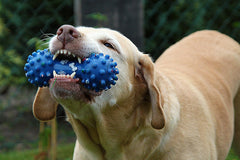
One of the best benefits of having a dog is that you get to teach them cool tricks. Everyone loves seeing dogs that can play dead, roll over, give paw, or do whatever other tricks there are out there. Teaching your dog some good dog tricks is not solely for your entertainment.
There's ample evidence that teaching dogs new tricks will boost their cognitive abilities and prevents cognitive decline as they age. As you might expect, some dog tricks are more straightforward to teach than others. It's much easier to teach dogs simple tricks before moving on to more complex ones. If you're looking to start training your dog, here are three skills and easy dog tricks with which you might want to start.
Give A Kiss

This "trick" is super simple and is one of the basic dog tricks to teach your dog. If you want your dog to give you a big kiss on command, the way to do so is simple. Put a little treat on your cheek and say "kiss" or whatever word you want. Then have your dog go after the food. If you repeat this a few times, your dog will eventually be able to kiss you whenever you ask for it!
Bark Or Be Quiet

If you want your dog to bark or be quiet on command, the way to do this is relatively straightforward. First, you'll likely want to teach the quiet command word (so that way you can stop your dog from barking later on!). Create a situation in which your dog will likely bark. Good examples of this are having someone ring the doorbell or having someone be outside the window. Grab a good training treat. Once your dog starts barking, say "quiet," "hush," or whatever other code words you want. Once they stop talking, go ahead and give them the treat. Keep repeating this until they learn that the word means to stop barking. The same method can teach your dog to bark. Except that, in this instance, you'll reward your dog for barking after you say "bark," or whatever other code words you want. Eventually, they'll learn that "bark" means they should speak, and "quiet" means they shouldn't!
Give Paw

Getting your dog to give you their paw is another straightforward trick. Most dogs like to use their legs, and, as such, it's an easy thing to encourage dogs to give you them. Much like the other training methods, this one also involves the use of treats. Essentially, the goal is to say paw while holding something in your hand that will make them want to grab at it. Eventually, your dog will learn that the word "paw" means that you want them to put their paw in your hand.
Train Your Dog For Fun And To Improve Their Cognitive Abilities!

If you want to train your dog, not only is it fun to do, but you will also improve their cognitive abilities. Consider teaching your dog to speak on demand, kiss you, or give paw. These are three simple tricks that shouldn't take too much time to teach your dog!




